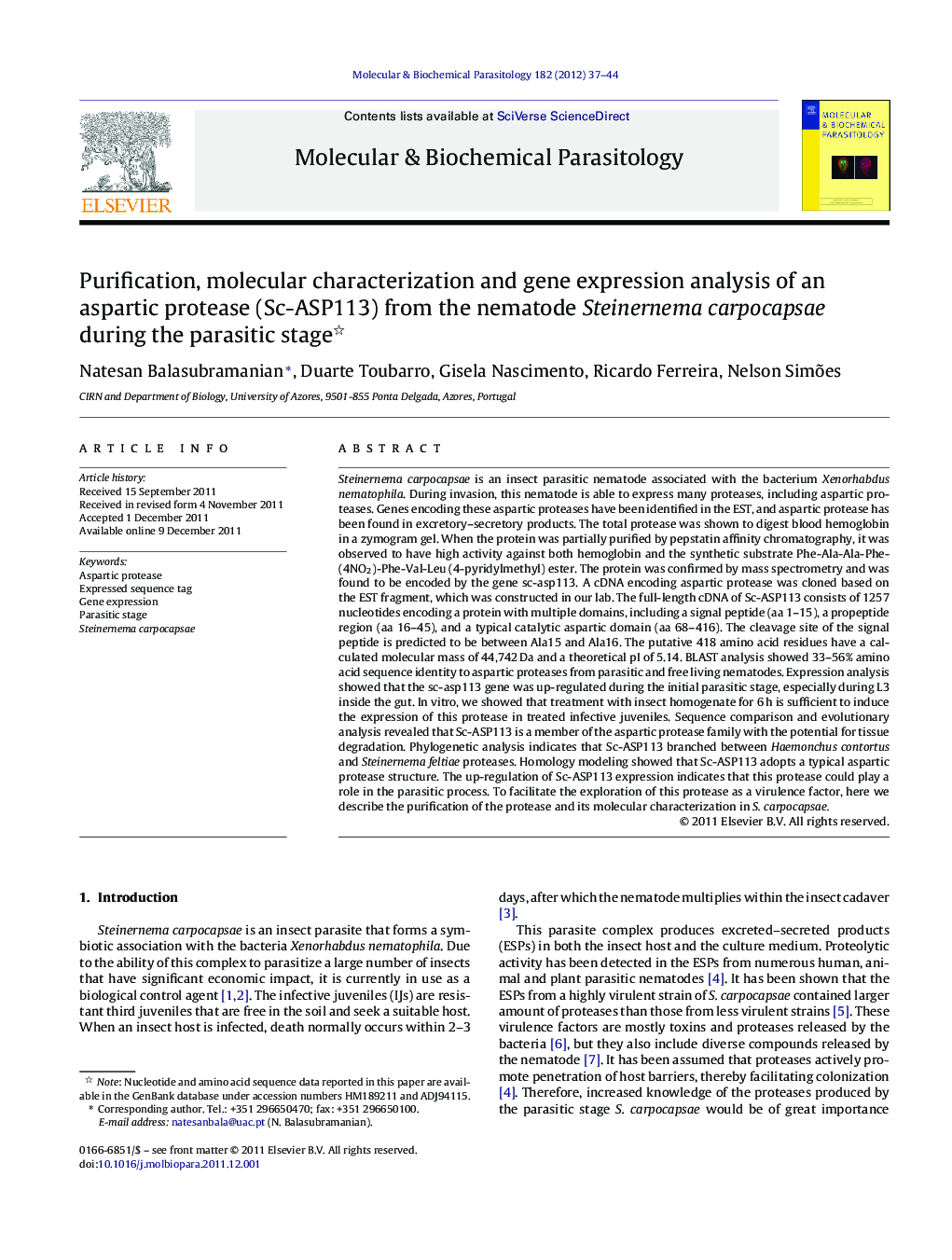| کد مقاله | کد نشریه | سال انتشار | مقاله انگلیسی | نسخه تمام متن |
|---|---|---|---|---|
| 2829844 | 1570655 | 2012 | 8 صفحه PDF | دانلود رایگان |

Steinernema carpocapsae is an insect parasitic nematode associated with the bacterium Xenorhabdus nematophila. During invasion, this nematode is able to express many proteases, including aspartic proteases. Genes encoding these aspartic proteases have been identified in the EST, and aspartic protease has been found in excretory–secretory products. The total protease was shown to digest blood hemoglobin in a zymogram gel. When the protein was partially purified by pepstatin affinity chromatography, it was observed to have high activity against both hemoglobin and the synthetic substrate Phe-Ala-Ala-Phe-(4NO2)-Phe-Val-Leu (4-pyridylmethyl) ester. The protein was confirmed by mass spectrometry and was found to be encoded by the gene sc-asp113. A cDNA encoding aspartic protease was cloned based on the EST fragment, which was constructed in our lab. The full-length cDNA of Sc-ASP113 consists of 1257 nucleotides encoding a protein with multiple domains, including a signal peptide (aa 1–15), a propeptide region (aa 16–45), and a typical catalytic aspartic domain (aa 68–416). The cleavage site of the signal peptide is predicted to be between Ala15 and Ala16. The putative 418 amino acid residues have a calculated molecular mass of 44,742 Da and a theoretical pI of 5.14. BLAST analysis showed 33–56% amino acid sequence identity to aspartic proteases from parasitic and free living nematodes. Expression analysis showed that the sc-asp113 gene was up-regulated during the initial parasitic stage, especially during L3 inside the gut. In vitro, we showed that treatment with insect homogenate for 6 h is sufficient to induce the expression of this protease in treated infective juveniles. Sequence comparison and evolutionary analysis revealed that Sc-ASP113 is a member of the aspartic protease family with the potential for tissue degradation. Phylogenetic analysis indicates that Sc-ASP113 branched between Haemonchus contortus and Steinernema feltiae proteases. Homology modeling showed that Sc-ASP113 adopts a typical aspartic protease structure. The up-regulation of Sc-ASP113 expression indicates that this protease could play a role in the parasitic process. To facilitate the exploration of this protease as a virulence factor, here we describe the purification of the protease and its molecular characterization in S. carpocapsae.
Figure optionsDownload high-quality image (197 K)Download as PowerPoint slideHighlights
► Sc-ASP113 aspartic protease was found in Zymogram and coding gene in EST library.
► Sc-ASP113 cDNA has 1257 bp, putative 418 amino acid mass was 44.7 kDa and pI 5.14.
► Sc-asp113 is a time dependent inducible gene and up-regulated in L3 in inside gut.
► Purified protein was confirmed by mass spectrometry to be encoded by sc-asp113 gene.
► The esophageal expression of sc-asp113 was confirmed, predicted signal peptides.
Journal: Molecular and Biochemical Parasitology - Volume 182, Issues 1–2, March–April 2012, Pages 37–44